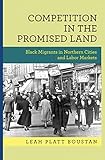Competition in the promised land : black migrants in northern cities and labor markets / Leah Platt Boustan.
Material type: TextSeries: NBER series on long-term factors in economic development: Publisher: Princeton, New Jersey : Princeton University Press, [2017]Copyright date: ©2017Description: xv, 197 pages : illustrations ; 25 cmContent type: text Media type: unmediated Carrier type: volumeISBN: 9780691150871; 0691150877Subject(s): African Americans -- Migrations -- History -- 20th century | Migration, Internal -- United States -- History -- 20th century | Rural-urban migration -- United States -- History -- 20th century | African Americans -- Economic conditions -- 20th century | African Americans -- Social conditions -- 20th century | BUSINESS & ECONOMICS / Economic History | BUSINESS & ECONOMICS / Labor | BUSINESS & ECONOMICS / Development / General | HISTORY / United States / 20th Century | HISTORY / Social History | African Americans -- Economic conditions | African Americans -- Migrations | African Americans -- Social conditions | Migration, Internal | Rural-urban migration | United States | Schwarze | Migration | Stadtökonomie | USA | 1900-1999Genre/Form: History.DDC classification: 305.896/073 LOC classification: E185.6 | .B77 2017Other classification: BUS023000 | BUS038000 | BUS092000 | HIS036060 | HIS054000
TextSeries: NBER series on long-term factors in economic development: Publisher: Princeton, New Jersey : Princeton University Press, [2017]Copyright date: ©2017Description: xv, 197 pages : illustrations ; 25 cmContent type: text Media type: unmediated Carrier type: volumeISBN: 9780691150871; 0691150877Subject(s): African Americans -- Migrations -- History -- 20th century | Migration, Internal -- United States -- History -- 20th century | Rural-urban migration -- United States -- History -- 20th century | African Americans -- Economic conditions -- 20th century | African Americans -- Social conditions -- 20th century | BUSINESS & ECONOMICS / Economic History | BUSINESS & ECONOMICS / Labor | BUSINESS & ECONOMICS / Development / General | HISTORY / United States / 20th Century | HISTORY / Social History | African Americans -- Economic conditions | African Americans -- Migrations | African Americans -- Social conditions | Migration, Internal | Rural-urban migration | United States | Schwarze | Migration | Stadtökonomie | USA | 1900-1999Genre/Form: History.DDC classification: 305.896/073 LOC classification: E185.6 | .B77 2017Other classification: BUS023000 | BUS038000 | BUS092000 | HIS036060 | HIS054000 | Item type | Current library | Call number | Copy number | Status | Notes | Date due | Barcode |
|---|---|---|---|---|---|---|---|
 Books
Books
|
Female Library | E185.6 .B77 2017 (Browse shelf (Opens below)) | 1 | Available | STACKS | 51952000327721 | |
 Books
Books
|
Main Library | E185.6 .B77 2017 (Browse shelf (Opens below)) | 1 | Available | STACKS | 51952000327738 |
Includes bibliographical references (pages 165-186) and index.
Introduction -- Black migration from the South in historical context -- Who left the South and how did they fare? -- Competition in northern labor markets -- Black migration, white flight -- Motivations for white flight : the role of fiscal/political interactions -- Black migration, northern cities, and labor markets after 1970.
"From 1940 to 1970, nearly four million black migrants left the American rural South to settle in the industrial cities of the North and West. Competition in the Promised Land provides a comprehensive account of the long-lasting effects of the influx of black workers on labor markets and urban space in receiving areas. Traditionally, the Great Black Migration has been lauded as a path to general black economic progress. Leah Boustan challenges this view, arguing instead that the migration produced winners and losers within the black community. Boustan shows that migrants themselves gained tremendously, more than doubling their earnings by moving North. But these new arrivals competed with existing black workers, limiting black-white wage convergence in Northern labor markets and slowing black economic growth. Furthermore, many white households responded to the black migration by relocating to the suburbs. White flight was motivated not only by neighborhood racial change but also by the desire on the part of white residents to avoid local public services and fiscal obligations in increasingly diverse cities. Employing historical census data and state-of-the-art econometric methods, Competition in the Promised Land revises our understanding of the Great Black Migration and its role in the transformation of American society."-- Provided by publisher.
1 2

There are no comments on this title.